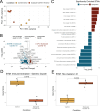This is a preprint.
COVID-19 induces persistent transcriptional changes in adipose tissue that are not associated with Long COVID
- PMID: 40501971
- PMCID: PMC12154766
- DOI: 10.1101/2025.05.23.655815
COVID-19 induces persistent transcriptional changes in adipose tissue that are not associated with Long COVID
Abstract
Long COVID is a heterogeneous condition characterized by a wide range of symptoms that persist for 90 days or more following SARS-CoV-2 infection. Now more than five years out from the onset of the SARS-CoV-2 pandemic, the mechanisms driving Long COVID are just beginning to be elucidated. Adipose tissue has been proposed as a potential reservoir for viral persistence and tissue dysfunction contributing to symptomology seen in Long COVID. To test this hypothesis, we analyzed subcutaneous adipose tissue (SAT) from two cohorts: participants with subacute COVID-19 (28-89 days post-infection) compared to pre-pandemic controls, and participants with Long COVID compared to those with those classified as "indeterminate" based on the RECOVER-Adult Long COVID Research Index (12-47 months post-infection). We found no evidence of persistent SARS-CoV-2 RNA in adipose tissue in any participant. SAT from participants with subacute COVID-19 displayed significant transcriptional remodeling, including depleted immune activation pathways and upregulated Hox genes and integrin interactions, suggesting resident immune cell exhaustion and perturbations in tissue function. However, no consistent changes in gene expression were observed between Long COVID samples and samples from indeterminant participants. Thus, SAT may contribute to inflammatory dysregulation following COVID-19, but does not appear to play a clear role in Long COVID pathophysiology. Further research is needed to clarify the role of adipose tissue in COVID-19 recovery.
Keywords: Long COVID; RNA Sequencing; SARS-CoV-2; Subacute COVID-19; Subcutaneous Adipose Tissue; Transcriptome.
Conflict of interest statement
Conflict of Interest JZL consults for Merck. CAB consults for Immunebridge on topics unrelated to the current research. All other authors declare that the research was conducted in the absence of any commercial or financial relationships that could be construed as a potential conflict of interest.
Figures



References
Publication types
Grants and funding
LinkOut - more resources
Full Text Sources
Research Materials
Miscellaneous
